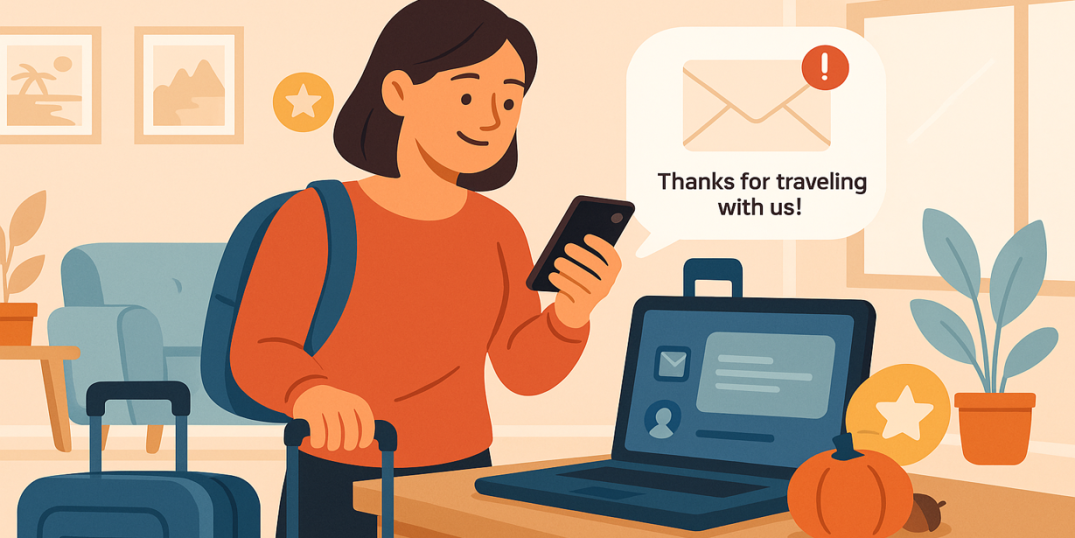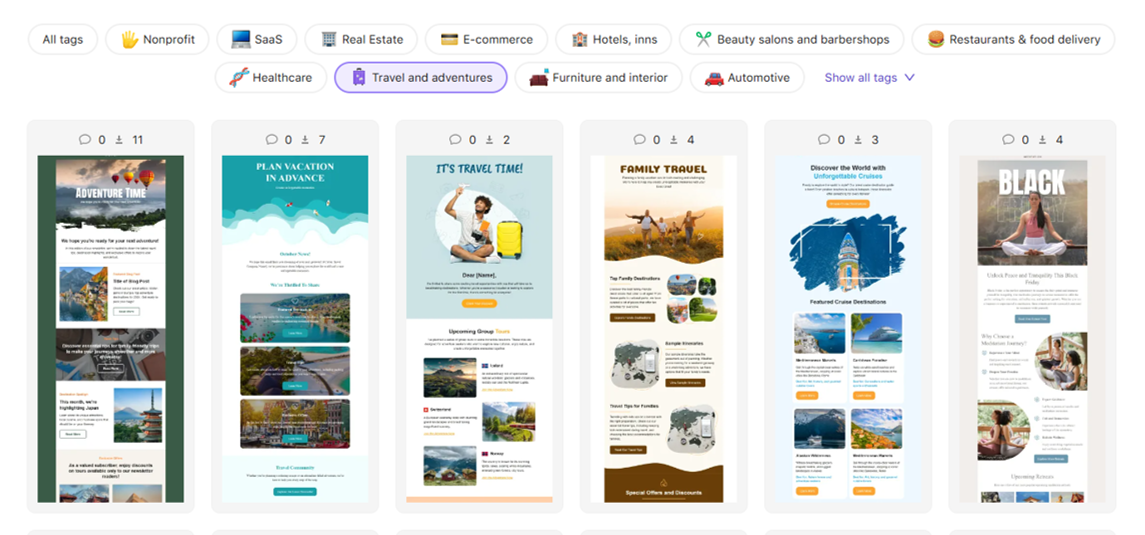- Home
- Email Templates
- Post-Trip Email Sequences That ...

We all want to carry the feeling of our vacation with us for as long as possible. Sometimes it lingers in the smell of freshly unpacked souvenirs or in the suntan we carry on our skin. But it can also live in something less obvious—a post-trip email. When sent at just the right moment, it can do more than remind travelers of what they had; it can spark anticipation for what’s still to come.
And here’s an interesting fact: automated email sequences generate 320% more revenue than manual emails. But their real power isn’t just in numbers. The magic of post-trip emails lies in their emotional weight—they can build genuine connections and create the kind of loyalty that lasts far beyond the journey itself.
So, next time you write your travel newsletter, think of it as more than a campaign. Think of it as an I-remember-you moment—a continuation of a story that turns travelers into loyal adventurers. In this article, we’ll explore how to design a post-trip email sequence that stays in people’s hearts and keeps them wanting to come back for more.
The Psychology of Post-Trip Engagement
✨ Travelers are in a “peak-end effect” state
We’ve all been on vacation, but have you ever consciously thought about which parts of our trips tend to be the most memorable ones? Usually, what we hold on to are the emotional peaks of our vacation—the last breathtaking view, the laughter on the final night, or that bittersweet moment of saying goodbye.
And what’s common in all of them is that they’re all related to some kind of ending. This is known as the psychological peak-end effect. This is why the end of an experience can completely color how the entire journey feels in memory. And that’s something marketers should pay close attention to. A post-trip email can become part of that memorable ending—like the aftertaste of a great journey.
✨ Use this insight to build goodwill and emotional resonance
When someone has just returned home after their vacation, for a while they are still emotionally overwhelmed, still somewhere between reality and the state of being away. A post-vacation follow-up email can fit right into that emotional window and bring them right back to those beautiful moments. When you show that their experience also mattered to you and do so at the right time, you transform this connection into real goodwill and become part of the traveler’s story.
✨ Connect it to loyalty behavior
When a journey ends on a warm, positive note, it creates a psychological imprint that says, I want to do this again. This exact feeling turns one-time travelers into returning customers. It is also good timing for a post-trip email sequence—a message that thanks them again after a few days or offers their next getaway. With these messages, you are extending the story for your customers and giving them a sense of future adventures that can be similarly good.
The 5-Email Post-Trip Sequence Framework
Each post-trip email serves a unique purpose—one closes a story, another opens a new one. Together, they form a natural rhythm: gratitude → reflection → storytelling → connection → anticipation. And that rhythm is what keeps travelers emotionally tied to your brand even after they unpack their luggage.
| Email type | When to send | Purpose/objective | Content highlights & example ideas |
| Thank-you & emotional closure | 1–2 days after return | Reinforce positive feelings, give emotional closure, and make travelers feel seen and appreciated. | • Mood: warm, heartfelt, sincere. |
| • CTA: “Share your favorite photo.” | |||
| • Visuals: one big, emotive hero image from the destination. | |||
| Feedback & reflection | 5–7 days after return | Collect feedback while the memory is fresh and turn it into a moment of care. | • Mood: appreciative, conversational, light. |
| • Incentive: small reward—bonus points, discount, or giveaway entry. | |||
| • Sign-off: “Your opinion helps us craft even better adventures.” | |||
| Memory & story sharing | 2–3 weeks after return | Keep the traveler emotionally connected and invite them to relive or share their adventure. | • Mood: nostalgic, storytelling, community-driven. |
| • CTA: “Share your adventure story” or “See what other travelers experienced.” | |||
| • Highlight: feature a few traveler quotes or short anecdotes. | |||
| Referral & loyalty invitation | 3–4 weeks after return | Transform satisfaction into advocacy and introduce loyalty rewards. | • Offer: introduce a travel loyalty email campaign or rewards system. |
| • Visuals: clean design with badge or milestone icon (“You’ve traveled 3,000 miles with us!”). | |||
| • Sign-off: “Welcome to our explorer circle.” | |||
| Next-trip inspiration & re-engagement | 6–8 weeks after return | Reignite excitement and guide the traveler toward their next adventure. | • Mood: inspiring, forward-looking, lightly persuasive. |
| • Personalization: use CRM/AI to suggest similar destinations (“Loved the Dolomites? Try the Pyrenees next.”). | |||
| • Visuals: striking destination photos + short teaser blurbs. |
Post-Trip Email Templates

This email template channels the right spirit for bike adventure lovers. A couple of weeks after they return is the perfect time to send it. That’s when the memories are still alive, but the traveler’s mind is already wandering toward the next trail.
The email provides plenty of well-structured, engaging information—from breathtaking imagery of new guided routes to highlights of professional biking gear and accessories. It keeps readers dreaming and planning at the same time.
The layout, which is clean and easy to navigate, also makes it fun to read. In short, this post-trip email has everything bike lovers need to stay in that excitement mode until their next big ride.
Sendigram collection for travel and adventure

If your marketing efforts are focused on promoting travel and adventure experiences, this collection is exactly what you need. Here, you’ll find plenty of fully customizable free HTML email templates designed to help you capture the excitement of any occasion—from Halloween to Valentine’s Day, from ski getaways to extreme bike tours. Each template is easy to edit, visually engaging, and built to fit your brand’s tone and style.
Pick the one that fits your campaign best, adjust it to your liking, and make it yours to shine.
Advanced Personalization Using Trip Data
✨ Pull data from itinerary history
If you think about it, you already have a lot of clues about a traveler’s journey. Where they went, how long they stayed, who they went with, even what kind of weather they had. And all that isn’t just data but an input for the story you can tell them in your next post-trip email.
If someone spent ten days in Bali, mention it—“Still dreaming of that turquoise water in Bali?” If they traveled with their partner, add a small romantic twist. And if it rained for half their vacation, maybe joke about it a little and suggest a sunnier destination next time. This way, you relate to their experiences and turn your emails into a conversation. And people remember conversations.
✨ Integrate with CRM tags or AI recommendations to personalize future offers
This is where we again remember that personalization can go much deeper than just adding a name to the subject line.
You will be surprised how much your CRM already knows—where your travelers went, what kind of trips they prefer, how often they book, and even the types of emails they tend to open. When you combine that with AI-driven tools, you then detect behavioral patterns—like when someone is most likely to start planning their next getaway or which destinations match their previous travel moods.
How does that work in practice? CRM tags can automatically do segmentation for travel email campaigns: “solo adventurers,” “family vacationers,” or “luxury seekers.” Then, AI steps in to recommend specific offers or destinations for each. With this approach, it does not even matter whether you’re sending fifty or fifty thousand emails, as each will feel personal.
✨ Tip: avoid generic “hope you enjoyed your trip” copy
“Hope you had a great trip!” sounds polite but also way too formal and impersonal. Instead of a formal sign-off, ask something personal, such as “Did you end up trying the local street food you mentioned?” This is way better, as it shows that you were paying attention. Over time, this kind of writing builds trust and makes your repeat booking email strategy work because people, in fact, truly enjoy hearing from you.
Common Mistakes to Avoid
⚠️ Sending too soon. When you send a post-trip email while travelers are still jet-lagged, you risk causing irritation more than interest. So, do not rush it.
⚠️ Skipping mobile optimization. Most travel email marketing messages are opened on a phone, often while people are still on the move. So, make sure your message is mobile optimized and CTAs are clearly tappable.
⚠️ Making the CTA too salesy. The goal of a post-trip email sequence is not sales but building a connection. This approach is particularly important in email marketing for travel agents, where genuine trust is foundational for any commercial success.
⚠️ Neglecting unsubscribe or frequency control. After the trip, not everyone wants constant updates. Always give travelers a clear option to adjust how often they hear from you.
⚠️ Forgetting visual storytelling. The emotion of travel lives in images. Think of visuals as a continuation of the journey—it is a way to help your travelers relive it just a little longer.
To Sum Up
A great journey doesn’t truly end when the plane lands—it continues in the memories and, sometimes, in the inbox. So, think of the post-trip email sequence as a bridge between what was and what’s next.
So, the next time you’re planning your post-trip email, don’t rush to sell another destination. Pause for a moment and think about the feeling you want to leave behind. Because sometimes, the most powerful marketing isn’t about selling the next trip—it’s about keeping the last one beautifully alive.



